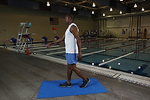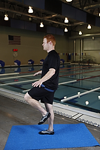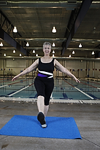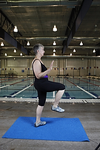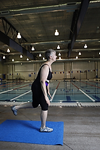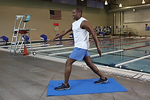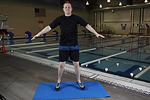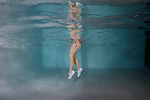Whether you are exercising on your own in the pool, or you are a water fitness instructor getting ready to teach a class, you need to have a collection of exercises you can use. You want exercises that are fun, and you probably want some of them to raise your heart rate into your target zone. Building an exercise library can seem like a daunting task.
It helps to remember that there are only a few basic exercises and all other exercises are variations of these. The basic exercises in shallow water are walk, jog, kick, rocking horse (shown as starting position and finish), cross-country ski, jumping jacks and jump.
Now how do you create variations of these exercises?
- Use different arm movements. Try arm swing (should flexion and extension), lat pull-down (shoulder abduction and adduction), shoulder sweep (horizontal shoulder abduction and adduction), arm curls (elbow flexion and extension), or rotator cuff sweep (shoulder external and internal rotation). Use only one arm, use both arms in unison, use alternating arms, or no arms.
- Vary the tempo. Water tempo is the normal speed used in water. Land tempo is faster, but you want to be sure not to lose your range of motion. Half water tempo adds a bounce on every other beat. You can also add variations in tempo such as pauses, doubles, and syncopate. An example of a pause is single, single, hold. Single, single, double means one right, one left, two right, and so on. Syncopate means slow, slow, quick quick, quick.
- Change the working position, also called the impact option. Exercises can be performed upright with some rebounding, in the neutral position with the hips and knees flexed to submerge the body to shoulder depth, suspended with the feet not touching the floor, and grounded or keeping one foot on the floor at all times.
- Increase the range of motion. Exercises can be performed with larger arm or leg movements, or the feet farther apart, or you can cross the mid-line of the body.
- Add acceleration or power, by pushing harder against the resistance of the water.
- Add turns. You can do quarter turns, half turns, or full turns. Diagonal turns are quarter turns toward the right corner, then toward the left corner.
- Travel. You can travel forward, backward, sideways, or on a diagonal. If you are traveling on a diagonal you do not face the direction of travel, which would be the same thing as traveling forward, but rather you continue to face forward while traveling toward a corner. You can travel in patterns, such as in a circle, square, bow-tie pattern, zig-zag, or scatter pattern.
- Combine exercises. Putting two or more exercises together creates a new exercise. Examples include the chorus line kick (which is one knee lift and one kick), quad kick front and side, jumping jacks squat, and ski-ski-kick-and-lunge.
Not every variation will work with every exercise. But using even a few variations will increase your exercise library tremendously.
Note: the photos are from my book, Water Fitness Lesson Plans and Choreography. For more information on the book, check out my website at www.waterfitnesslessons.com

